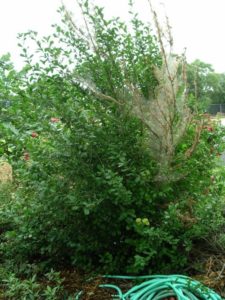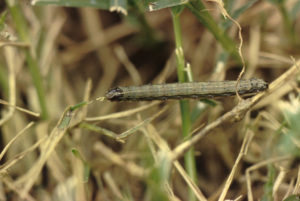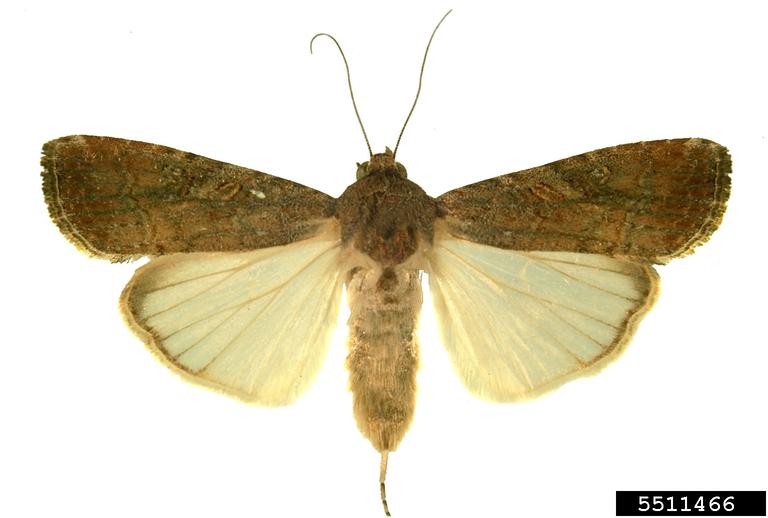Bagworms, webworms, army worms, there are a lot of different “worms” out there that can make your shrubs and trees look unsightly. Depending on where you live in Texas you might have seen one of them and wonder what you should do about them. Before you get too confused, while worm is in the name they are really caterpillars. And we know that caterpillars will cocoon and turn into a moth or butterfly.
Bagworms:
 Bagworms can be seen hanging from the twigs of a variety of trees and shrubs. They are recognized by the distinctive 1.5 to 2 inch long spindle-shaped cocoons that they make. The cocoons are made from a combination of silk that they spin, along with leaf, twig and bark material from the host tree that they are feeding on.
Bagworms can be seen hanging from the twigs of a variety of trees and shrubs. They are recognized by the distinctive 1.5 to 2 inch long spindle-shaped cocoons that they make. The cocoons are made from a combination of silk that they spin, along with leaf, twig and bark material from the host tree that they are feeding on.
- Form small cases that hold larvae, pupae, or female adults and eggs
- Cases are often found on evergreen trees & shrubs such as cedar, juniper, cypress, or pine
- Cases are made from silk and plant material laid down similar to shingles on a house, overlapping in layers
- Newly hatched larvae spin a silken thread & either are carried to a new plant by wind or attach themselves to the plant they are on and begin to build their own silken bag
- Bags remain on plants even if bagworms are dead
- Bags are transportable; larvae carry them along as they move about the plant
- To manage bagworms, handpick bags off the plant and dispose of them
Check out this link to Dr. Merchant’s webpage on bagworms
Webworms or Tent Caterpillars:
 Fall webworms are another caterpillar that may be confused with bagworms. The female moth will lay a cluster of a few hundred eggs on the underside of the leaves of a host plant in the spring and the eggs hatch approximately one week later. After hatching, the larvae immediately begin spinning silken webs for protection from predators while they are feeding. The caterpillars will skeletonize leaves so that only the veining structure remains. The webs initially start at the tip of branches and can eventually extend all the way down to the trunk of a tree.
Fall webworms are another caterpillar that may be confused with bagworms. The female moth will lay a cluster of a few hundred eggs on the underside of the leaves of a host plant in the spring and the eggs hatch approximately one week later. After hatching, the larvae immediately begin spinning silken webs for protection from predators while they are feeding. The caterpillars will skeletonize leaves so that only the veining structure remains. The webs initially start at the tip of branches and can eventually extend all the way down to the trunk of a tree.
- Spin webbing over branches of host tree to enclose foliage they feed upon
- Attack over 88 species of plants, including fruit, nut, and ornamental trees and shrubs
- Use web as a protective covering; spin webbing immediately after hatching out of egg
- Webbing remains on tree even if caterpillars are dead/ no longer there
- Webs can be pruned out of the tree or opened with a stick/ spray of water to allow predators to eat caterpillars
- When using a pesticide, webbing still needs to be opened
In the event you need to control this pest, here are some control tactics you can use:
Less toxic active ingredients for management include Bacillus thuringiensis (Green Category) variety kurstaki, which targets only caterpillars or spinosad (Green Category) which targets insects that feed heavily on foliage. Both of these active ingredients must be consumed to work properly, so good coverage of foliage is important. Consider treating with these products in the evening so they won’t degrade as quickly as using them during the day where they begin to break down quickly from sunlight. Bt and spinosad work best on smaller stages of caterpillars (less than ½ an inch); once caterpillars are larger it is best to use a residual contact pesticide (Yellow Category). Synthetic pesticides include active ingredients such as permethrin, cyfluthrin, carbaryl, or acephate (Yellow Category). Read the label to check what plants products may be used on and read and follow all label instructions. Remember if you use a Yellow Category product to complete a justification form as well.
For more information on fall webworms check out this factsheet
Fall Armyworms:
 Fall armyworms are approximately 1-1½ inches long, depending on instar, and can vary in color from a green to mottled brown, to almost black. Armyworms attack many different kinds of plants. When food is scarce, they will move to plants that are not normally attacked. Thus, armyworms can be found on nearly any plant as they migrate in search of edible foliage. Besides warm-season turfgrasses, plants attacked by armyworms include grain and forage sorghum, corn, small grains, sweet potato, beans, turnip, clover, tobacco, spinach, cucumber, potatoes, tomatoes, cowpeas, cabbage, bluegrass and others.
Fall armyworms are approximately 1-1½ inches long, depending on instar, and can vary in color from a green to mottled brown, to almost black. Armyworms attack many different kinds of plants. When food is scarce, they will move to plants that are not normally attacked. Thus, armyworms can be found on nearly any plant as they migrate in search of edible foliage. Besides warm-season turfgrasses, plants attacked by armyworms include grain and forage sorghum, corn, small grains, sweet potato, beans, turnip, clover, tobacco, spinach, cucumber, potatoes, tomatoes, cowpeas, cabbage, bluegrass and others.
- Weather conditions that favor the fall armyworm is above average rains in August and September.
- Because armyworm moths are strong fliers, outbreaks can also occur when storms move the moths and allow them to escape natural enemies. Armyworms should be controlled when they occur in large numbers or plant damage is becoming excessive.
- Damaged areas of lawns appear off-color and eventually turn brown as damage progresses from small windowpane strips of damaged leaf tissue to destruction of entire leaves. Armyworms feed any time of the day or night, but are most active early in the morning or late in the evening.
- Treat with a labeled insecticide when leaf damage becomes evident and large numbers of caterpillars are visible. Effective, low-impact insecticides include halofenozide (small caterpillars only) and spinosad (Both are Green Category). Bacillus thuringiensis (Bt) products are widely available and will selectively control small armyworm larvae without harm to beneficial insects; however, Bt residues does not last on turf for more than 1-2 days. Conventional insecticide (Yellow Category) choices for armyworms in lawns include bifenthrin, carbaryl, esfenvalerate, permethrin and others.
For more information on Fall Armyworms check out the AggieTurf website
Special thanks to Dr. Mike Merchant and Wizzie Brown for information and some of the images in this issue of School Pest News.



 .
.